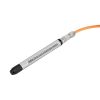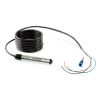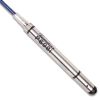Global Water WL400 Vented Water Level Sensor
Features
- Monitor levels in groundwater wells, rivers, streams, tanks, lift stations and open channels
- Dynamic temperature compensation system for high accuracy and reliability
- Vented pressure sensor for automatic barometric pressure compensation
- Free ground shipping
- Expedited repair and warranty service
- Lifetime technical support
- More
Each of the water level sensors consist of a solid state submersible pressure transducer encapsulated in a stainless steel 13/16 inch diameter housing. The water level sensor has a molded waterproof cable and a two-wire 4-20mA output for connection to a monitoring device. A 25 ft cable is standard, and optional cable lengths are available up to 500 ft.
The Water Level Sensor's submersible pressure transducer is fully encapsulated with marine-grade epoxy so that moisture can never leak in or work its way down the vent tube to cause drift or level sensor failure. The sensor uses a unique, highly flexible silicon diaphragm to interface between water and the sensing element. This silicon diaphragm protects the water level sensor's electronics from moisture and provides each sensor with exceptional linearity and very low hysteresis.
Water level ranges of 0-3, 0-15, 0-30, 0-60, 0-120, and 0-250 feet are available. The 0-3 ft low-level range is ideal for measuring shallow flows or small water level changes like those encountered in sewers, storm drains, weirs, and flumes. The 0-3 ft water monitoring sensor accurately measures small changes in water, even when the water's depth is only a few inches deep.
In The News
Supplying Seattle’s Drinking Water: Using Data Buoys to Monitor the Cedar River Municipal Watershed
Providing clean, safe, and reliable drinking water for the 1.6 million people in the greater Seattle area is a top priority for Seattle Public Utilities (SPU). With limited water supplies, SPU dedicates considerable resources to maintain its watersheds and mountain reservoirs. About 70 percent of Seattle Water comes from the Cedar River Municipal Watershed , and the other 30 percent comes from the South Fork Tolt River Watershed . [caption id="attachment_39574" align="alignnone" width="940"] Data buoy in Chester Morse Lake . (Credit: Kevin Johnson / Seattle Public Utilities) [/caption] Jamie Thompson, a fisheries biologist at SPU, monitors aquatic ecosystems centered on fish listed under the U.S. Endangered Species Act (ESA).
Read MoreData-Driven Advocacy on the Lower Deschutes River
Like many freshwater environments, the Deschutes River in Oregon is under pressure from development, pollution, and climate change. Many rivers, streams and lakes in the Deschutes Basin do not meet Oregon water quality standards –where state water quality monitoring assesses levels of bacteria, pH, dissolved oxygen, temperature, and fine sediment. Hannah Camel is the Water Quality Coordinator for the Deschutes River Alliance (DRA), a non-profit organization that focuses on the health of the lower 100 miles of the Deschutes River–the area most affected by human intervention. As a data-driven organization, the DRA has benefited from the installation of two NexSens X2 data loggers.
Read MoreExpanding the Port Everglades: Real-Time Monitoring of Water Quality Conditions from Planned Dredging Operation
The Port Everglades in Broward County, Florida, serves large trade vessels and cruiseliners and incoming and outgoing recreational boaters. However, as cargo ships become larger, the port must expand. A dredging project led by the US Army Corps of Engineers will substantially deepen and widen the port's navigation channel to accommodate larger Panamax cargo ships and modern cruise liners. As a result of this project, a large amount of sediment will be displaced into the water column. This suspended sediment may settle outside of the project area, burying benthic organisms like corals, and possibly carrying harmful particulates to other regions. [caption id="attachment_39497" align="aligncenter" width="2560"] A CB-950 and CB-25 deployed on site at Port Everglades.
Read More























































